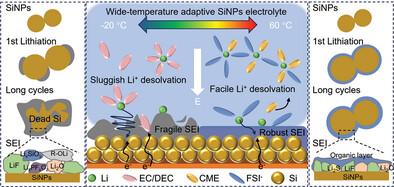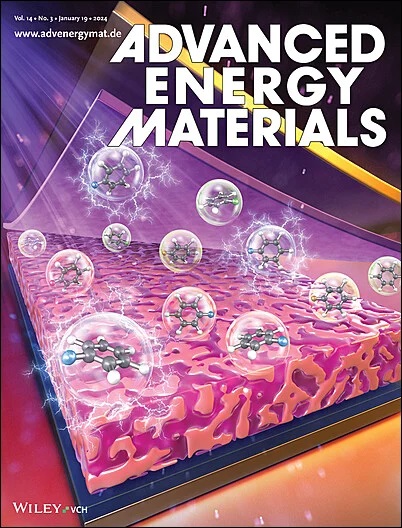Anionic Aggregates Induced Interphase Chemistry Regulation toward Wide-Temperature Silicon-Based Batteries
IF 24.4
1区 材料科学
Q1 CHEMISTRY, PHYSICAL
引用次数: 0
Abstract
Silicon nanoparticles (SiNPs) show great promise as high-capacity anodes owing to their ability to mitigate mechanical failure. However, the substantial surface area of SiNPs triggers interfacial side reactions and solid electrolyte interphase (SEI) permeation during volume fluctuations. The slow kinetics at low temperatures and the degradation of SEI at high temperatures further hinder the practical application of SiNPs in real-world environments. Here, these challenges are addressed by manipulating the solvation structure through molecular space hindrance. The electrolyte enables anions to aggregate in the outer Helmholtz layer under an electric field, leading to rapid desolvation capabilities and the formation of anion-derived SEI. The resulting double-layer SEI, where inorganic nano-clusters are uniformly dispersed in the amorphous structure, completely encapsulates the particles in the first cycle. The ultra-high modulus of this structure can withstand stress accumulation, preventing electrolyte penetration during repeated expansion and contraction. As a result, SiNPs-based batteries demonstrate exceptional electrochemical performance across a wide temperature range from −20 to 60 °C. Moreover, the assembled 80 mAh SiNPs/LiFePO4 pouch cells maintain a cycling retention of 85.6% after 150 cycles, marking a significant step forward in the practical application of silicon-based batteries.

阴离子聚集体诱导相间化学调节,实现宽温硅基电池
由于硅纳米粒子(SiNPs)具有减轻机械故障的能力,因此很有希望成为高容量阳极。然而,SiNPs 巨大的表面积会在体积波动时引发界面副反应和固体电解质间相(SEI)渗透。低温下的缓慢动力学和高温下的 SEI 降解进一步阻碍了 SiNPs 在实际环境中的应用。在这里,我们通过分子空间阻碍操纵溶解结构来应对这些挑战。电解质可使阴离子在电场作用下聚集在外层亥姆霍兹层中,从而实现快速解溶解能力并形成阴离子衍生的 SEI。由此形成的双层 SEI(无机纳米簇均匀地分散在无定形结构中)可在第一个循环中完全包裹颗粒。这种结构的超高模量可承受应力累积,防止电解质在反复膨胀和收缩过程中渗透。因此,基于 SiNPs 的电池在 -20 至 60 °C 的宽温度范围内都能表现出卓越的电化学性能。此外,组装好的 80 mAh SiNPs/LiFePO4 袋装电池在循环 150 次后仍能保持 85.6% 的循环保持率,这标志着硅基电池的实际应用向前迈出了重要一步。
本文章由计算机程序翻译,如有差异,请以英文原文为准。
求助全文
约1分钟内获得全文
求助全文
来源期刊

Advanced Energy Materials
CHEMISTRY, PHYSICAL-ENERGY & FUELS
CiteScore
41.90
自引率
4.00%
发文量
889
审稿时长
1.4 months
期刊介绍:
Established in 2011, Advanced Energy Materials is an international, interdisciplinary, English-language journal that focuses on materials used in energy harvesting, conversion, and storage. It is regarded as a top-quality journal alongside Advanced Materials, Advanced Functional Materials, and Small.
With a 2022 Impact Factor of 27.8, Advanced Energy Materials is considered a prime source for the best energy-related research. The journal covers a wide range of topics in energy-related research, including organic and inorganic photovoltaics, batteries and supercapacitors, fuel cells, hydrogen generation and storage, thermoelectrics, water splitting and photocatalysis, solar fuels and thermosolar power, magnetocalorics, and piezoelectronics.
The readership of Advanced Energy Materials includes materials scientists, chemists, physicists, and engineers in both academia and industry. The journal is indexed in various databases and collections, such as Advanced Technologies & Aerospace Database, FIZ Karlsruhe, INSPEC (IET), Science Citation Index Expanded, Technology Collection, and Web of Science, among others.
 求助内容:
求助内容: 应助结果提醒方式:
应助结果提醒方式:


